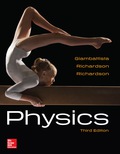
Concept explainers
(a)
What is the chipmunk’s total displacement?
(a)
Answer to Problem 23P
The total displacement of chipmunk is
Explanation of Solution
The chipmunk travels a distance of
Let us take right side to be positive and left side to be negative. The direction and distance travelled by chipmunk is shown in figure 1 below.
Write the equation to find the total displacement of chipmunk.
Here,
Conclusion
Substitute
Since the displacement is negative, its direction is towards the left.
Therefore, the total displacement of chipmunk is
(b)
What is the average speed of chipmunk in a time of
(b)
Answer to Problem 23P
The average speed of chipmunk is
Explanation of Solution
Write the equation to find the total distance travelled by chipmunk.
Here,
Write the equation to find the average speed.
Here,
Conclusion:
Substitute
Substitute
Therefore, The average speed of chipmunk is
(c)
What is the average velocity of chipmunk?
(c)
Answer to Problem 23P
The average velocity of chipmunk is
Explanation of Solution
Write the equation to find the total displacement by chipmunk.
Here,
Write the equation to find the average speed.
Here,
Conclusion:
Substitute
Substitute
Therefore, The average speed of chipmunk is
Want to see more full solutions like this?
Chapter 2 Solutions
Physics
- 3aarrow_forward44 please help with the this.arrow_forward4a Which of the following values COULD NOT be a magnitude? Choose all that apply. 626 0 -0.806 8.63 -48.5 72 131 156 4b Px = -1248 & Py = 261. Determine P.P = Qx = -1540 & Qy = 375. Determine Q.Q = 4c. T = 1105 & Ty = 425. Determine the two possible values for Tx. 4d. Uy = -38. Which of the following COULD NOT be the value of U? Choose all that apply. 10 70 72 31 47 0 75 38 4e. R has a magnitude of 165. Which of the following COULD be Rx? Choose all that apply. 165 -171 155 0 -156 -165 172 -130arrow_forward
 College PhysicsPhysicsISBN:9781305952300Author:Raymond A. Serway, Chris VuillePublisher:Cengage Learning
College PhysicsPhysicsISBN:9781305952300Author:Raymond A. Serway, Chris VuillePublisher:Cengage Learning University Physics (14th Edition)PhysicsISBN:9780133969290Author:Hugh D. Young, Roger A. FreedmanPublisher:PEARSON
University Physics (14th Edition)PhysicsISBN:9780133969290Author:Hugh D. Young, Roger A. FreedmanPublisher:PEARSON Introduction To Quantum MechanicsPhysicsISBN:9781107189638Author:Griffiths, David J., Schroeter, Darrell F.Publisher:Cambridge University Press
Introduction To Quantum MechanicsPhysicsISBN:9781107189638Author:Griffiths, David J., Schroeter, Darrell F.Publisher:Cambridge University Press Physics for Scientists and EngineersPhysicsISBN:9781337553278Author:Raymond A. Serway, John W. JewettPublisher:Cengage Learning
Physics for Scientists and EngineersPhysicsISBN:9781337553278Author:Raymond A. Serway, John W. JewettPublisher:Cengage Learning Lecture- Tutorials for Introductory AstronomyPhysicsISBN:9780321820464Author:Edward E. Prather, Tim P. Slater, Jeff P. Adams, Gina BrissendenPublisher:Addison-Wesley
Lecture- Tutorials for Introductory AstronomyPhysicsISBN:9780321820464Author:Edward E. Prather, Tim P. Slater, Jeff P. Adams, Gina BrissendenPublisher:Addison-Wesley College Physics: A Strategic Approach (4th Editio...PhysicsISBN:9780134609034Author:Randall D. Knight (Professor Emeritus), Brian Jones, Stuart FieldPublisher:PEARSON
College Physics: A Strategic Approach (4th Editio...PhysicsISBN:9780134609034Author:Randall D. Knight (Professor Emeritus), Brian Jones, Stuart FieldPublisher:PEARSON





